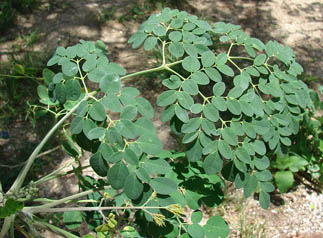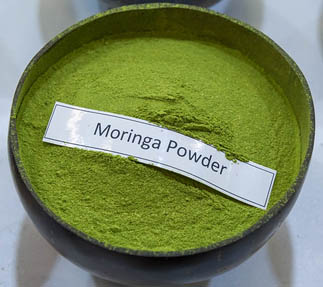Moringa leaves Nutrition facts
Moringa leaves are nutritious foliage of the Moringa oleifera, also called drumstick or horseradish tree. The leaves and flowers eaten as potherb while tender, are an excellent source of minerals, antioxidants, vitamins, and dietary fiber.
The cultivation of moringa in the Indian sub-continent occurs mainly in the southern states of India, Bangladesh, and Pakistan.
Some of local names of moringa in India are Sehjan, Murungai, Moonga, Shevga, etc.
 |
| Moringa leaves. (Photo: Forest & Kim Starr) |
Moringa is a small, fast-growing, deciduous, dicotyledonous tree in the family Moringaceae, native to sub-Himalayan regions of Northern India. The plant is also naturalized in tropical Africa and American regions.
Its spreading, open crown of drooping, fragile branches covered with compound, tripinnate leaves up to 45 cm long with conspicuous swellings (pulvini) where the parts join. twigs.
The leaflets are alternate and spirally arranged on the twigs; 1.2 to 2cm long and 0.5 to 1 cm wide.
The leaflets are finely hairy, green, and almost hairless on the upper surface, paler and hairless beneath, rounded or blunt-pointed at the apex, and short-pointed at the base.
Harvesting
Moringa Leaves for harvesting exclusively for its foliage are planted very closely in the field. They are ready for harvesting after the plant grows 3-5 ft, which usually takes 60-75 days in well-drained fertile soil.
Harvesting is done by cutting leaf stems with a sharp knife. Harvesting in this manner will promote the development of new shoots.
Subsequent harvesting is done by every alternate month. Moringa leaves can easily lose moisture; so, harvest early in the morning.
Flowers, pods, leaves, and even twigs are cooked and eaten.
Health benefits of Moringa leaves
Moringa leaves are one of the moderate-calorie leafy vegetables. 100 g of fresh leaves hold 64 calories. Nonetheless, they are packed with several vital phytochemicals, anti-oxidants, vitamins, and minerals that immensely benefit overall health.
Phytonutrients and antioxidants in the drumstick leaves play an important role that helping reduce some diabetes symptoms, protecting cardiovascular and liver health, and supporting brain health.
Fresh leaves are a rich source of folates. 100 g of fresh greens contain 40 µg or 10% of folates. Folic acid helps prevent neural tube defects in newborns when advised in anticipant mothers.
Moringa leaves are nature's highest source of vitamin A. 100 g fresh leaves hold 7,560 IU of vitamin A. Studies found that vitamin A and flavonoid compounds in green leafy vegetables help humans protect from skin, lung, and oral cavity cancers.
Moringa leaves are abundant in the B-complex group of vitamins such as thiamin, riboflavin, niacin, vitamin B-6 (pyridoxine), and pantothenic acid that are essential for optimum cellular enzymatic and metabolic functions.
Fresh drumstick leaves contain very high levels of vitamin-C (100 g hold 51.7 mg or 57% of RDI). However, moringa pods carry three times more vitamin C than their leafy greens.
Vitamin C is a powerful, natural anti-oxidant. Foods rich in this vitamin help the human body protect from scurvy disease, develop resistance against infectious agents (boosts immunity), and scavenge harmful, pro-inflammatory free radicals from the body.
They also are a moderate source of minerals, especially calcium, magnesium, phosphorus, and iron. They are packed with a small amount of other essential minerals and electrolytes such as potassium, manganese, selenium, and zinc.
| Principle | Nutrient Value | Percent of RDA |
|---|---|---|
| Energy | 64 Kcal | 3.2% |
| Carbohydrates | 8.28 g | 6% |
| Protein | 9.4 g | 17% |
| Total Fat | 1.4 g | 7% |
| Cholesterol | 0 mg | 0% |
| Dietary Fiber | 2 g | 5% |
| Vitamins | ||
| Folates | 40 µg | 10% |
| Niacin | 2.22 mg | 14% |
| Pantothenic acid | 0.125 mg | 2.5% |
| Pyridoxine | 1.2 mg | 9% |
| Riboflavin | 0.66 mg | 5% |
| Thiamin | 0.257 mg | 21% |
| Vitamin C | 51.7 mg | 57% |
| Vitamin A | 7560 IU | 252% |
| Electrolytes | ||
| Sodium | 9 mg | 0.6% |
| Potassium | 337 mg | 7% |
| Minerals | ||
| Calcium | 185 mg | 18.5% |
| Copper | 0.105 mg | 12% |
| Iron | 4 mg | 50% |
| Magnesium | 42 mg | 10.5% |
| Manganese | 1.06 mg | 46% |
| Phosphorus | 112 mg | 16% |
| Zinc | 0.60 mg | 5.5% |
Selection
Although fresh moringa leaves are readily available around the year, they are in season in the spring in South Asia. The tender leafy tips and flower buds are much sought after in the cuisine across South and South East Asia.
Choose fresh, crisp, bright green, and undamaged leaves in tiny bundles. Avoid sunken, dry, yellow, and bruised leaves as they are out of flavor.
Storage
Moringa leaves spoil early if not stored adequately. Use them within 1-2 days of harvest.
Storage conditions for Moringa leaves are similar to those for other leafy greens like spinach. At home, store in plastic bags in the refrigerator for up to 2 days set at 32°F-34°F (0°-1°C) and 95% relative humidity. Do not deep freeze.
Preparation and serving methods
Moringa leaves are used as a potherb in the cuisine across many South Asian regions.
To prepare, trim away any tough stems rinse under cold water, and shake off excess water, or pat dry using a cloth.
To enjoy the healthy nutritional aspects of moringa leaves, do not overcook; eat them just lightly steamed or sauteed.
Here are some serving tips:
 |
| Moringa leaf powder. (Photo: Marco Verch) |
Moringa leaves are eaten sautéed in vegetable stir-fries, cooked with lentils and other leafy greens as a potherb, alone or in a mix with other leafy greens like spinach, etc., in many South-Asian countries.
Murungai Keerai (Drumstick Leaves) Poriyal is a special south Indian stew recipe cooked with moong beans, grated coconut and spices, and condiments.
Drumstick leaves dal/Kootu recipe is a special dish served over steamed rice.
Dried moringa leaves powder is employed in healthy and flavorful soups and cakes.
In the Philippines (malunggay), where they are marketed all around the season, moringa leaves are used liberally in soups, stews with fish, prawns, and poultry.
In the Philippines, fresh leaves are cooked in coconut milk to prepare ginattang malunggay.
Dry and powdered moringa leaves can be added to the diet to improve the nutritional quality in Africa and Asia. Bread, muffins, pastry, rolls, and cakes can be prepared by mixing M.oleifera powder with wheat, maize, and rice flour.
Safety profile
Phytates and dietary fiber present in the moringa leaves may interfere with the bioavailability of minerals like iron, calcium, and magnesium.
Its leaves, when eaten in large quantities, may cause stomach upset, gaseous distension, and loose stools due to their laxative properties. (Medical disclaimer).
Also read ≻≻-
≻≻- Drumstick (moringa) pods nutrition facts.
≻≻- Pea shoots nutrition facts.
≻≻- Arugula (Salad rocket) nutrition facts.
≻≻- Back to Vegetables from Moringa leaves. Visit here for an impressive list of vegetables with complete illustrations of their nutrition facts and health benefits.
≻≻- Back to Home page.
Further reading and references:
M. oliefera- Trees Of Life.
USDA -Drumstick Leaves: Nutrient Database for Standard Reference.
Moringa oliefera- IIAASD (International Institute of Advanced Agriculture Skill Development)
Gopalan, C., B.V. Rama Sastri, and S.C. Balasubramanian. Nutritive value of Indian foods. Hyderabad, India: (National Institute of Nutrition), 1971 (revised and updated by B.S. Narasinga Rao, Y.G. Deosthale, and K.C. Pant, 1989).